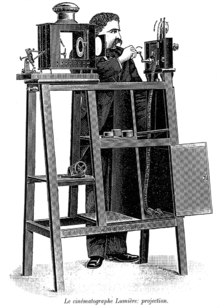
Кинематограф или кинематограф - это ранний термин, обозначающий несколько типов механизмов кинофильмов. Это название использовалось для кинокамер , а также кинопроекторов или для комплексных систем, которые также предоставляли средства для печати фильмов (например, Cinématographe Lumière).

Устройство с таким названием было изобретено и запатентовано под названием « Кинематограф Леона Були» французским изобретателем Леоном Були 12 февраля 1892 года. Були ввёл термин «кинематограф» от греческого « письмо в движении». [1] Из-за нехватки денег Були не мог должным образом развивать свои идеи и поддерживать гонорары за патенты, поэтому братья Люмьер могли свободно принять это имя. [2] В 1895 году они применили его к устройству, которое по большей части было их собственным изобретением.
В том же году братья Люмьер сняли свой первый фильм « Рабочие, покидающие фабрику Люмьер» ( Sortie de l'usine Lumière de Lyon ). Первый коммерческий публичный показ кинематографических фильмов состоялся 20 мая 1895 года на Бродвее, 156 в Нью-Йорке, когда был представлен « Эйдолоскоп », изобретенный Вудвиллом Лэтэмом и Юджином Лаустом . [3] Тем не менее, это часто ошибочно приписывают первой выставке Люмьера 28 декабря 1895 года в Salon Indien du Grand Café в Париже, организованной братьями Люмьер. [4] На этой презентации было представлено десять короткометражных фильмов, в том числе новая версия « Рабочие покидают фабрику Люмьер» . [4] Каждый из этих ранних фильмов имел длину 17 метров (приблизительно 56 футов), что при ручном включении проектора длилось примерно 50 секунд.


Louis Lumière and his brother Auguste worked together to create a motion-picture camera superior to Thomas Edison's kinetograph, which did not have a projector. The Lumières endeavored to correct the flaws they perceived in the kinetograph and the kinetoscope, to develop a machine with both sharper images and better illumination. The Cinématographe weighed only 16 lb (7.3 kg), which allowed for ease of transportation and placement. As well, the Cinématographe was manually operated by a hand-crank, as opposed to Edison's electrically powered camera, which was not readily portable. Furthermore, while only one person at a time could use Edison's kinetoscope for viewing through an eyepiece-- an early model of a viewfinder. The Cinématographe could project an image onto a screen so a large audience of people could view images simultaneously.[5]
The Cinématographe produced a sharper projected image than had been seen before due to its design, in which a kind of fork held frames behind the lens in place using the perforations in the sides of the film strip.
In 1897, the Lumières further added to their invention by using a glass flask of water as the condenser to concentrate the light onto the film frame and to absorb heat. The flask also acted as a safety feature, as the light would no longer focus on the flammable film if the glass were to break due to overheating or accident.[6]
After the success of the Lumières's initial public screening in 1895, the Cinématographe became a popular attraction for people all over the world. The Lumière brothers took their machine to China and India[5] and it was enjoyed by people of all classes and social standings. The Cinématographe was used to show films in nickelodeons, where even the poorest classes could pay the entry fee. It was exhibited at fairs and used as entertainment in vaudeville houses in both Europe and the United States. While vaudeville is typically associated with the working and middle classes, the machine also found its way into more sophisticated venues, where it appealed to the artistic tastes of high society.[1]
Ang, Tom. 2019. Photography: History, Art, Technique, 2005–2019.